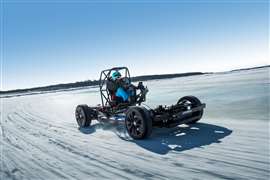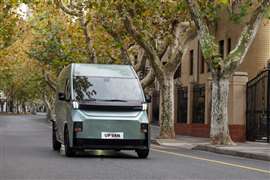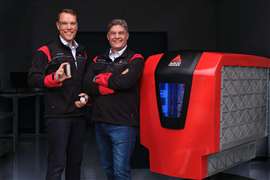Read this article in Français Deutsch Italiano Português Español
U Power Tech targets North American markets with EV skateboard chassis
21 May 2025
The “skateboard” vehicle chassis is not a new development. In a November 2023 article posted to the website Medium, commercial electric vehicle (EV) maker U Power Tech said General Motors first unveiled it at the 2002 North American International Auto Show.
Designed specifically for alternative power supplies such as batteries, the skateboard chassis — so named because its flat profile and four wheels resembles a skateboard — incorporates all a vehicle’s core capabilities into a single integrated platform. These include propulsion, suspension, braking and steering. Such an approach offers certain advantages to vehicle makers.
U Power, which is based in China but has its North American headquarters in Sunnyvale, Calif., aims to apply its own skateboard chassis design — the UP Super Board — to light-duty commercial electric vehicles involved in urban logistics and specialty applications.
“The lack of options in the North American market for EVs really means that there are a lot of opportunities,” said Yao Zhai, co-founder of U Power and general manager for the company’s North American business, of the Class 2 vehicles that are U Power’s focus. “When we bring a new product to this market, we really don’t see a lot of competition.”
Speed to Market
U Power sees a number of advantages to its skateboard chassis in developing its own EVs and supporting customers seeking to do the same. One is development speed.
 The UP Super Board skateboard chassis, which incorporates all key operational components of an electric vehicle. (Photo: U Power Tech)
The UP Super Board skateboard chassis, which incorporates all key operational components of an electric vehicle. (Photo: U Power Tech)
“The benefit of that is that you can roll out new electric vehicles much faster than the traditional way of developing and manufacturing new EVs,” Zhai said. This is because the components integrated into the chassis do not have to be engineered and integrated separately.
Zhai shared two examples of this efficiency as it relates to U Power’s chassis. One was in a consumer vehicle — a new SUV produced by New York EV maker and U Power customer Olympian Motors.
“From scratch, on the whiteboard, all the way to a prototype running on the road — they had a tech day in San Francisco [when] they drove the car on the road — that took almost eight months,” Zhai said. “This is something that has never been done before. Without the rolling chassis design, it is impossible.”
He also related a commercial EV example: U Power’s own cargo van.
“From the first design phase all the way to the end, which is the SOP (standard operating procedure) for large quantity production, it took us only 16 months,” Zhai said, adding that such a timeline was similarly unprecedented, with 24 months from concept to mass production being more typical with traditional chassis.
According to Zhai, the skateboard chassis offers other benefits to EV makers. These include a reduced bill-of-materials (BOM) cost for an EV.
“Imagine different vehicles, all sitting on the same skateboard chassis,” he said, “or very similar in terms of size and dimension. That gives you a lot of volume and negotiating power with your supply chain, thereby lowering the key component cost and then yielding that value to your customer.”
Another key advantage is in vehicle customization. Zhai said the skateboard chassis makes it easier for truck body outfitters to implement unique designs for specific applications.
“Players like Shyft or Morgan Olson, they do those highly customized vehicles,” he said. “With a skateboard chassis design, that enables them to do it very easily compared to a traditional EV chassis.”
 U Power’s UP Van is designed for urban logistics and last-mile delivery. (Photo: U Power Tech)
U Power’s UP Van is designed for urban logistics and last-mile delivery. (Photo: U Power Tech)
The ability to customize is enhanced further by the role the chassis plays in a crash.
“The upper body also bears a lot of responsibility to absorb the impact,” Zhai said of traditional commercial vehicle bodies. “With the skateboard chassis, most of the impact will be absorbed by the skateboard itself. So, the upper body has very little — I think probably 10 to 15 percent — of the impact absorption.”
As such, Zhai said that truck body makers can be even more creative in designing commercial EVs.
EV Adoption Challenges
With an eye for making inroads in the North American market, U Power exhibited several of its electric vehicles at the recent ACT Expo. Nonetheless, Zhai noted several headwinds regarding commercial EVs in North America. The most obvious are in the U.S., with the tariffs applied by the current administration.
“It’s very challenging to make long-term investment decisions,” he said. “I think it’s moving toward the right direction, and we’re hoping that it settles down quickly.”
Another key challenge is infrastructure, particularly compared to China. Zhai said that while U.S. states like California as well as certain parts of the East Coast have invested in charging infrastructure, large swaths of the country remain underserved.
“When I visit, for example, Indiana or Ohio — even Detroit (Mich.) — I don’t really see a lot of charging infrastructure, which is quite challenging for customers who really want to buy. They don’t know where to charge, and it gives them anxiety,” he said.
Then there is what Zhai sees as fragmented government incentives and an inconsistent regulatory environment among the U.S. states.
“Sometimes they [have] policies coming out, and then they take [them] away, so it’s really not very stable,” he said. “In the end, investment decisions cannot be made based on the fragmented regulatory environment.”
Forecast for EVs
In terms of commercial EVs in the future, Zhai said that not all classes will enjoy the same adoption rates.
“The low-end EVs in terms of class, I see that’s going to grow significantly, from Class 1 to maybe Class 3 or 4,” he said. “I think the reason is the fast development and growth of e-commerce.”
He added that total cost of ownership (TCO) will play a similarly important role.
“I think because of high gas prices and also high maintenance costs, the transition from gas vehicles to commercial EVs in the commercial space — I think it will accelerate quite significantly as the infrastructure matures,” Zhai said.
However, he added that he doesn’t see similar rapid growth for heavier-duty commercial EVs.
“Battery technology has not reached the point where it is mature enough and the energy density is high enough to support those vehicles,” Zhai said. “You need to have a really huge and very heavy battery to support Class 8 vehicles.”
He added that batteries of such size and weight can affect the vehicle’s overall payload.
“If there are breakthroughs in terms of battery technology where you can pack more energy with the same dimensions and same weight, then we might see acceleration in that higher-class vehicles space also,” Zhai said.
POWER SOURCING GUIDE
The trusted reference and buyer’s guide for 83 years
The original “desktop search engine,” guiding nearly 10,000 users in more than 90 countries it is the primary reference for specifications and details on all the components that go into engine systems.
Visit Now
STAY CONNECTED




Receive the information you need when you need it through our world-leading magazines, newsletters and daily briefings.
CONNECT WITH THE TEAM













